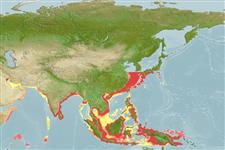Common names from other countries
Environment: milieu / climate zone / depth range / distribution range
Sinh thái học
; Mức độ sâu 0 - 175 m (Ref. 109). Tropical; 34°N - 10°S, 48°E - 155°E
Indo-West Pacific: from Persian Gulf to India, east to Papua New Guinea, and north to Japan and China. Introduced in the Mediterranean.
Length at first maturity / Bộ gần gũi / Khối lượng (Trọng lượng) / Age
Maturity: Lm 8.6, range 6 - 6.5 cm Max length : 12.9 cm TL con đực/không giới tính; (Ref. 409); 14 cm TL (female)
Maximum body length: 9.0 cm (male); 14.0 cm (female); common body length between 6.0 to 8.0 cm (Ref. 409). Maximum total length (male) from Ref. 119750. Common length range: 6.5 to 10.9 cm, male. Common weight range: 3.7 to 13.5 cm, male (Ref. 76922). Maximum depth from Ref. 409. Juveniles inhabit subtidal edge of mud flats, near inshore and far inshore waters (Ref. 121464). On muddy bottoms close to the shore, up to a depth of 85 m (Ref. 801). Also found near mouth areas of estuaries (Ref. 106567). Burrows in mud during the day time, with only the tube-like antennular flagella sticking out for respiration (Ref. 409).
Mating behavior: Precopulatory courtship ritual is common (through olfactory and tactile cues); usually indirect sperm transfer (Ref. 833).
Holthuis, L.B. 1980. (Ref. 8)
IUCN Red List Status (Ref. 130435)
CITES status (Ref. 108899)
Not Evaluated
Not Evaluated
Human uses
Các nghề cá: Tính thương mại
| FishSource | Biển chung quanh ta
Các công cụ
Các nguồn internet
Estimates based on models
Preferred temperature
(Ref.
115969): 13.8 - 29.1, mean 27.8 (based on 2170 cells).
Thích nghi nhanh
Chiêù cao, thời gian nhân đôi của chủng quần tối thiểu là dưới 15 tháng (K=1.18-2).
Vulnerability
Low vulnerability (10 of 100).
Price category
Unknown.
